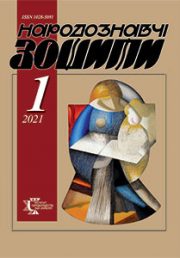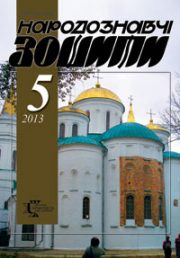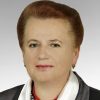The Ethnology Notebooks. 2024. № 2 (182), 317—326
UDK 75.071.1(477)(092)Прокуда
DOI https://doi.org/10.15407/nz2025.02.317
YATSIV Roman
- ORCID ID: https://orcid.org/0000-0003-1509-5367
- PhD, professor at the Artwood department
- of the Lviv National Academy of Arts,
- 38, V. Kubiyovycha str., 79011, Lviv, Ukraine,
- Contacts: e-mail: jaciv@ukr.net
Abstract. The article is devoted to the creative biography and legacy of Wolodymyr Prokuda (1923—2008), a Ukrainian painter and graphic artist who went through difficult life trials during the Second World War — from repression, the Soviet prison on Lontskyi in Lviv, the fascist concentration camps Auschwitz and Mauthausen, and to forced emigration to Germany and the USA. For the first time, the little-known facts of his professional formation, dramatic circumstances of his imprisonment and repression by two totalitarian regimes — Moscow and German-fascist — the resumption of artistic creativity in new historical and everyday realities, the sphere of influence on his aesthetic worldview, as well as the stages of development of his author’s concept of painting and graphics are introduced into academic circulation. Given the limited access to the resources of the artist’s creative heritage, the publication uses materials from the private correspondence of W. Prokuda with the author. The relevance of the article lies in the fact that for the first time in the historical and art history fields of science, the complex of issues of overcoming by the artist the consequences of the «traumatic memory» acquired by the war, limitations of creative freedom, restoration of emotional resources for the implementation of a long-term artistic program is considered. In accordance with the set goal, the entire set of facts related to the life of W. Prokuda in the extreme conditions of the war and the forms and content of his work in exile in Germany and the USA is described. Special attention is paid to the problem of transformation of the artist’s methodology in the paradigm of his value beliefs and search for his author’s style. The object of research is the creative heritage of W. Prokuda (painting and graphics) and a set of biographical factors that influenced his work, the subject is the problem of post-apocalyptic transformations in his work in the context of the history of Ukrainian and world fine arts of the 20th century.
The methodological basis of the research is creative-biographical, scientific-reconstructive and formal-analytical methods, with a combination of socio-psychological approaches to the interpretation of the concept of «traumatic consciousness» and its role in the realization of formalistic ideas of painting.
Keywords: Wolodymyr Prokuda, World War II, fine art, painting, book graphics, modernism, expressionism, totalitarian regimes, «traumatic memory», prison on Lontskyi, concentration camp Auschwitz, Birkenau concentration camp, Mauthausen concentration camp, Lviv, New York, national cultural heritage.
Received 13.03.2025
REFERENCES
- Keyvan, I. (1996). Ukrainian Artists Outside the Homeland. Edmonton; Montreal [in Ukrainian].
- Pevny, B. (2005). The First Fifteen Years. Masters of Our Art: Reflections on Artists and Art (Pp. 341—362). New York: Ukrainian Free Academy of Sciences in the USA; Kyiv: Suchasnist [in Ukrainian].
- Solovij, Ju. (1978). About Things Greater Than Stars. About Art, About Artists, About Miscellaneous, About Yourself. New York: Suchasnist [in Ukrainian].
- Mehyk, P. (Ed.). (1981). Ukrainian art in Diaspora. Philadelphia, Pa.: Ukrainian Art Digest [in Ukrainian and English].
- Shmagalo, R. (2002). Dictionary of artists-pedagogues of Uk raine and from Ukraine in the world. 1850—1950. Lviv [in Ukrainian].
- Stelmashchuk, H. (Ed.). (2013). Ukrainian artists in the world: materials on the history of the Ukrainian art of the 20th century. Lviv [in Ukrainian].
- (2009—2018). Encyclopedia of Ukrainian Diaspora. United States of America: in three books (Vol. 1). New York; Chicago [in Ukrainian].
- Yatsiv, R. (2025). Volodymyr Prokuda: Steps Towards a Name. Retrieved from: https://photo-lviv.in.ua/volodymyr-prokuda-kroky-nazustrich-imeni/ [in Ukrainian].
- Letter from Volodymyr Prokuda to R. Yatsiv dated March 1, 1994. Stored in the author’s private archive [in Ukra inian].
- The mentioned and cited archival materials are located at the resource: Retrieved from: https://digital col lec ti ons.its-arolsen.org/03020101/name/view/3154 433? lang= enPRO KUDA, WOLO DYMYR
- Letter from Volodymyr Prokuda to R. Yatsiv dated June 25, 1993. Stored in the author’s private archive [in Ukrainian].
- Letter from Volodymyr Prokuda to R. Yatsiv dated September 1, 1994. Stored in the author’s private archive [in Ukrainian].
- Gunther Franke. Retrieved from: https://en.wikipedia.org/wiki/G%C3%BCnther_Franke
- (1959, April 1). Exhibition of Images and Sculptures in New York. Svoboda (Part 62). New York [in Ukrainian]. Solovij, Ju. (1978). Where do bridges lead? (Before the first exhibition of Prokudy). About Things Greater Than Stars. About Art, About Artists, About Miscellaneous, About Yourself. New York: Suchasnist [in Ukrainian].







